|
Pakistan’s river system consists of more than 60
small and large rivers. Indus River, with an overall length of around
3200 KM and total estimated annual flow of 207 billion cubic meters, is
Pakistan’s longest and largest river. This is a list of some rivers
wholly or partly in Pakistan.
|
|
Shaksgam River
The Shaksgam River is a left tributary of the Yarkand River. The river
is also known as the Kelechin River and Muztagh River. It rises in the
Gasherbrum, Urdok, Staghar, Singhi and Kyagar Glaciers in the Karakoram.
It then flows in a general northwestern direction parallel to the
Karakoram ridge line in the Shaksgam Valley. The river valley was
explored in 1889 by Francis Younghusband (who referred to the Shaksgam
as the Oprang)., and again in 1926 by Kenneth Mason, who confirmed the
sources of the river. The upper river valley is used by climbers
approaching the north face of K2. The approach requires a crossing of
the river, which is hazardous. Between its confluence with the Shimshal
Braldu River and its confluence with the Oprang River the river forms
the border between China and Pakistan. The area is used as winter
pastures by yak herdsmen from the village of Shimshal, and is the only
part of Pakistan in the Tarim Basin. |
|
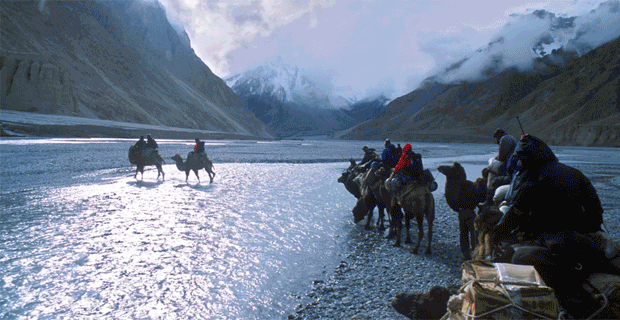 |
|
Shigar River
Shigar River is located in Baltistan, Northern Areas, Pakistan. The
Shigar River is formed from the melt water of the Baltoro Glacier and
Biafo Glacier. It flows through the Shigar Valley. The river is
tributary to Indus River and meets the Indus in Skardu Valley. |
|
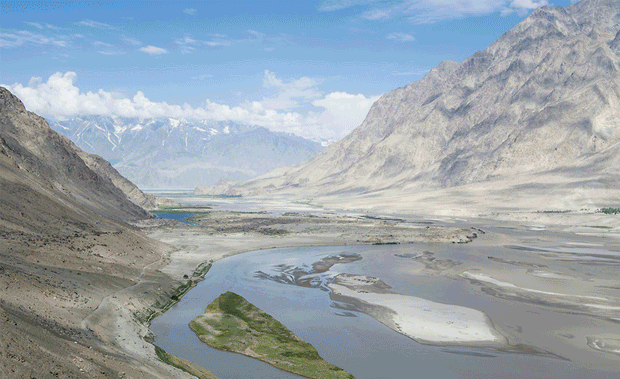
|
|
Shyok River
The Shyok River (literally "the river of death" in Yarkandi) flows
through northern Ladakh in India and the Northern Areas of Pakistan (Ghangche
District), spanning some 550 km (340 mi). The Shyok River, a tributary
of the Indus River, originates from the Rimo Glacier, one of the tongues
of Siachen Glacier. The river widens at the confluence with the Nubra
River. The alignment of the Shyok river is very unusual, originating
from the Rimo glacier, it flows in a southeasterly direction and,
joining the Pangong range, it takes a northwestern turn, flowing
parallel to its previous path. The Shyok flows in a wide valley,
suddenly entering a narrow gorge after Chalunka, continuing through
Turtuk and Tyakshi before crossing into Pakistan. The Shyok joins the
Indus at Keris, to the east of the town of Skardu. |
|
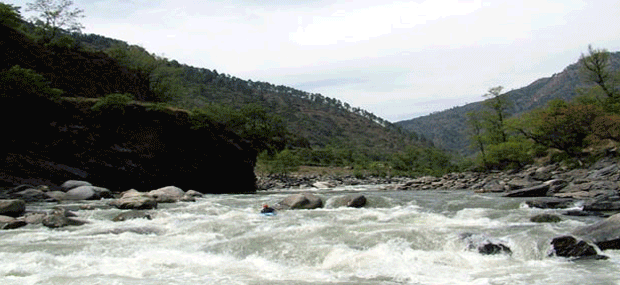
|
|
Neelum River
The Neelum River is a river in the Kashmir region of India and
Pakistan.The Neelam River originates from Krishansar Lake in the
vicinity of Sonamarg and runs northwards to Badoab village where it
meets a tributory from the Dras side and runs westwards along the Line
of Control in Jammu and Kashmir. It is fed by many glacial tributory
streams on its way. It enters Pakistan Administered Kashmir in the
Gurais sector of the Line of Control, and then runs west until it meets
the Jhelum River north of Muzzafarabad. The Neelum River is 245
kilometers long, it covers 50 kilometers in Jammu and Kashmir and the
remaining 195 kilometers in Azad Kashmir. |
|
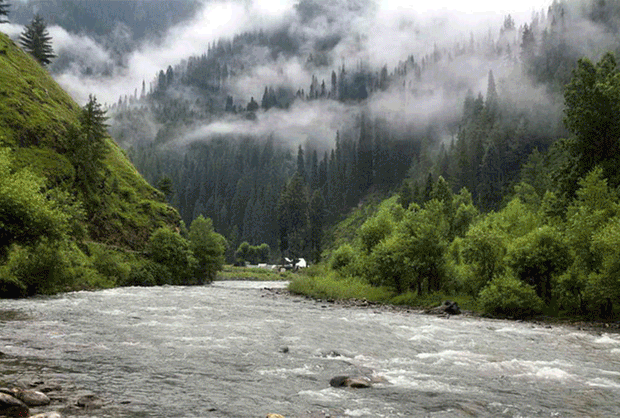 |
|
Gambila River
The Gambila River also called the Tochi river, is located in Bannu
District, Khyber Pakhtunkhwa province, the former North-West Frontier
Province, northern Pakistan. The source of the river lies in the hills
six miles south of the Sufed Koh, the source of the Kurram River, to
which it runs parallel and finally joins. It borders North Waziristan
while the Gomal River borders South Waziristan. The Gambila is an
important river for the inhabitants of the Dawar valley, as it serves to
irrigate a large area of land that it runs through, particularly that
belonging to the Takhti Khel Marwats, Bakkakhel Wazirs, and Miri and
Barakzai Bannuchis.
|
|
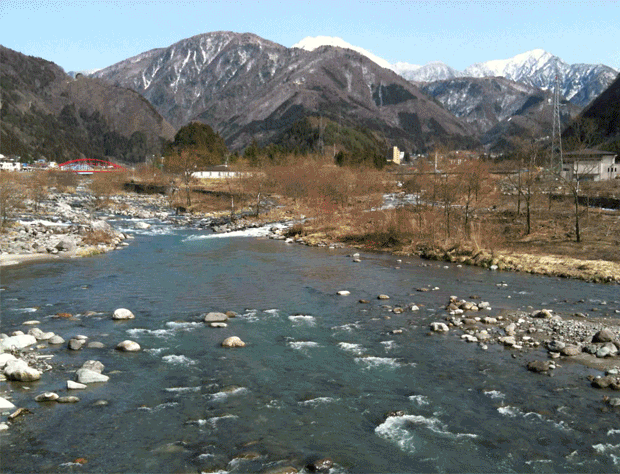 |
|
Panjnad River
Panjnad River is a river at the extreme end of Bahawalpur district in
Punjab, Pakistan. Panjnad River is formed by successive confluence of
the five rivers of Punjab, namely Jhelum, Chenab, Ravi, Beas and Sutlej.
Jhelum and Ravi join Chenab, Beas joins Sutlej, and then Sutlej and
Chenab join to form Panjnad 10 miles north of Uch Sharif in Bahawalpur
district. The combined stream runs southwest for approximately 45 miles
and joins Indus River at Mithankot. The Indus continues into the Arabian
Sea. A dam on Panjnad has been erected; it provides irrigation channels
for Punjab and Sindh provinces south of the Sutlej and east of the Indus
rivers.
|
|
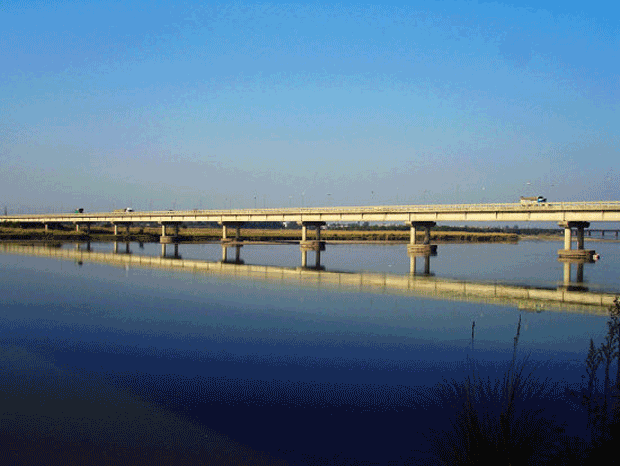 |
|
Panjkora River
The Panjkora River (Sanskrit: गौरी) is a river in northern Khyber
Pakhtunkhwa, northwestern Pakistan. It rises rises high in the Hindu
Kush at lat. 35.45, flows south through Upper Dir and Lower Dir
Districts and joins the Swat River near Chakdara, Malakand, Khyber
Pakhtunkhwa.The Panjkora Valley contains important sites of the Gandhara
grave culture. The Talash Valley, 13 kilometres (8.1 mi) from Chakdara,
is full of Buddhist remains. Buddhist stupas and monasteries which have
not been excavated are on both sides of the road towards Dir. At the
west end of the valley is the Kat Kala Pass. Olaf Caroe identified this
place with Massaga which was captured by Alexander the Great in 327BC.
There are also crumbling remains of a massive Hindu Shahi fort of the
8th to 10th centuries.
|
|
 |
|
Poonch River
The Poonch River is a river in Jammu and Kashmir, India and Azad Kashmir
in Pakistan. It originates in the western foothills of Pir Panjal range,
in the areas of Neel-Kanth Gali and Jamian Gali. It is called 'Siran' in
this area. It flows to the north west. At first flowing southwards it
enters Mangla Lake near Chomukh. The towns of Poonch, Sehra, Tatta Pani
and Kotli are situated on the banks of this river. It has two
tributaries, Betaar and Suwan.
|
|
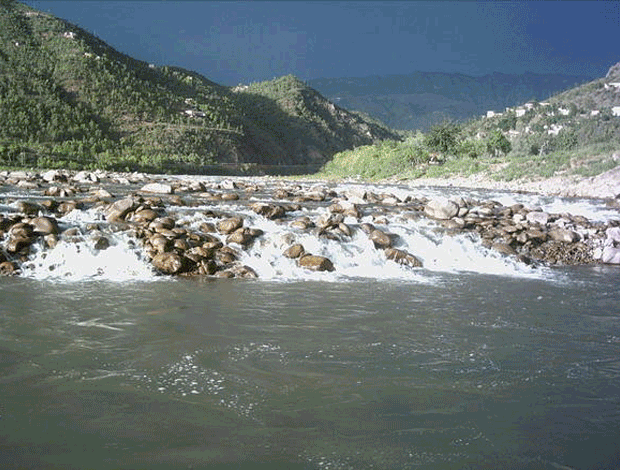 |
|
Dori River
The Dori, also called Lora and Kadanai is a river of Afghanistan and
Pakistan. It is a tributary of the Arghandab River and sub tributary of
the Helmand River and runs for 320 kilometres through Kandahar Province
in Afghanistan and Balochistan in Pakistan. The Dori begins north of the
city of Quetta. It is called Lora in its headwaters in Pakistan. The
name changes to Kadanai upon its entry into Afghanistan, and the name
Dori is given below the town of Spin Baldak. |
|
 |
|
Zhob River
Zhob River is located in Balochistan and Khyber Pakhtunkhwa, Pakistan.
The name is Iranian in its origin and etymologically identical to those
of the Little Zab and Great Zab rivers in Iraq and the Pamirs. In Pashto
language, Zhob means "oozing water". The total length of Zhob river is
410 km, and it flows in a north eastern course. It starts from the
boundary of Balochistan and Fata,in the north western Balochistan and
reaches till the Toba Kakar Range. The Zhob River originates in the Kan
Metarzai range (Tsari Mehtarazai Pass). It passes about 4 km away from
Zhob city. The Zhob River is a tributary of the Gomal River, which it
joins near Khajuri Kach.[1] The Gomal River then joins the Indus River
20 miles south of Dera Ismail Khan.
|
|
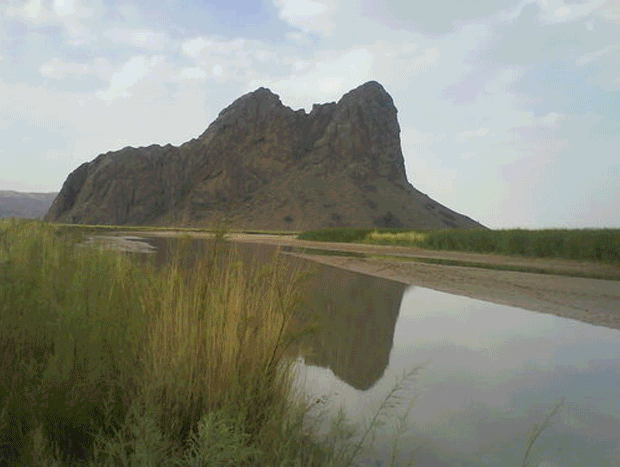 |
|
Click Here For Part-1
|